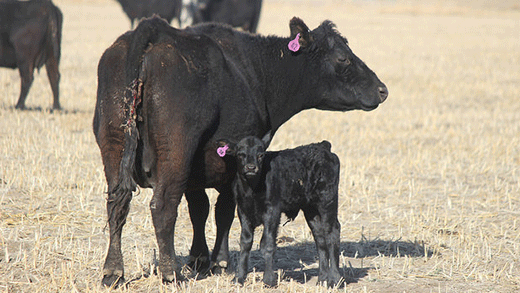
Maintaining cows in good condition and raising calves in a clean environment are two steps in minimizing death loss of calves.
Ways to minimize death loss in calves
K-State beef experts offer common sense advice
March 17, 2020
MANHATTAN, Kan. – Growing up on a livestock operation teaches agriculturists such life lessons as the value of hard work, the miracle of birth, the joy of caring for animals and, sometimes, the loss of livestock.
Recently, experts from the Kansas State University Beef Cattle Institute tackled the topic of calf death loss on a weekly podcast. Leading the discussion was veterinarian Bob Larson with BCI director and veterinarian Brad White.
“Nationally, beef producers lose about 2% of calves at birth or within the first 21 days of life, and another 2% prior to weaning,” Larson said. He noted that there are wide herd-to-herd and year-to-year variations in those numbers.
These losses are attributed to difficult births or diseases such as scours that can weaken the calves in their first few weeks of life.
“Difficult births can cause the calf to be born dead, but also those that survive may be weak and unable to get up and get the necessary colostrum,” Larson said.
One of the factors that White said contributes to birthing difficulties relates to cow nutrition.
“If the cows are really thin that can lead to calving challenges and potentially hamper nutrition for the calf, so it is important to maintain the cows in good body condition,” White said.
Larson added: “A cow that is thin often doesn’t have enough energy reserve to take care of her calf.”
One of the ways to support body condition for cows consuming low-quality forage is through protein supplementation.
“In late gestation a cow will need a couple pounds of protein,” Larson said. “She typically will get a pound from low quality forage available this time of year and the balance will need to come through a cube or some other form of a protein supplement.”
Larson encouraged producers to work with their veterinarian or nutritionist to calculate the correct amount of supplementation needed for their management situation.
Another factor to minimize calf death loss relates to the environment.
“We prefer to have cows calve on grass rather than in a dry lot where there is more potential for mud,” Larson said. White added it is also important to make sure the cows and calves are current on their vaccinations.
For those who are experiencing calf death loss, White stressed the importance of understanding why that is happening in the herd.
“Your biggest category of death can’t be an ‘unknown cause’ because it is very hard to solve that problem,” he said.
More information on this topic is available on a weekly podcast produced by the Beef Cattle Institute.
